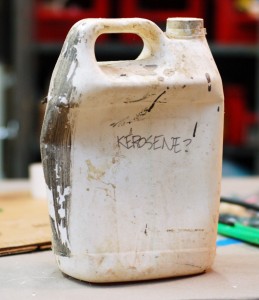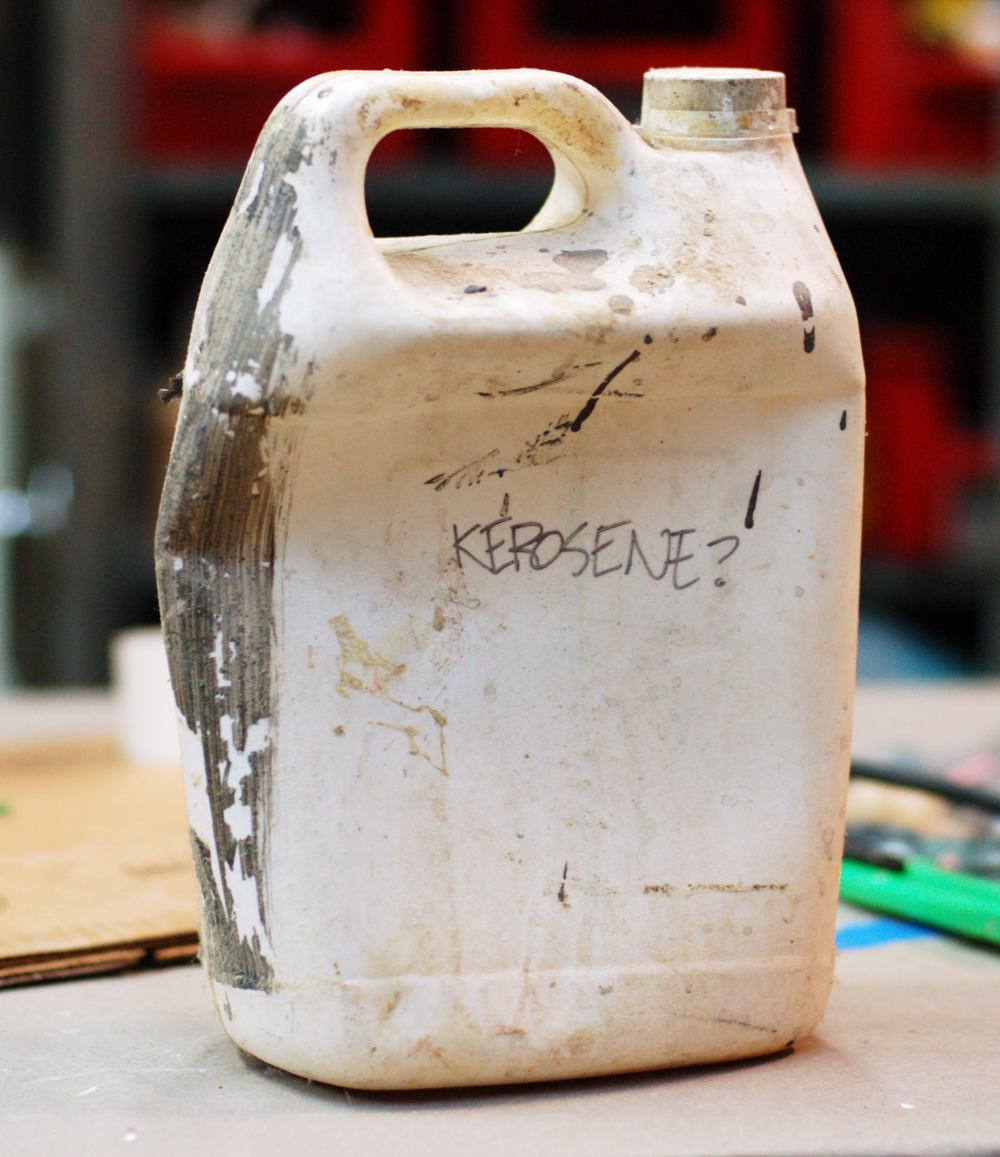Here is a funny item I found a few years back while cleaning out a theatrical props shop:

Once you stop laughing, you should realize it’s not actually funny. It’s serious: deadly serious. A container without a proper label can potentially contain any number or combination of hazardous chemicals, and should be treated as such. If you are just a hobbyist or sole proprietor of a shop, you should follow the proper labeling of chemicals for the reasons I give in the last two paragraphs of this article. If you work in a company with more than ten employees in the United States of America, then you are legally obligated to follow the OSHA regulations on Hazard Communication, which have strict and well-defined rules for labeling of products. You should know these whether you are the employer or employee (technically, as an employee, your employer is required to make sure you know these rules and train you if you don’t). The ten employee–rule does not apply just to the prop shop; the whole company is counted. If you count up the employees in finance, literary, scenery, marketing, lighting, box office, casting, etc., you will probably find that most theatres employ way more than ten people.
Part of the OSHA regulation on Hazard Communication (1910.1200) states what is needed for labeling:
“Labels and other forms of warning.”
The chemical manufacturer, importer, or distributor shall ensure that each container of hazardous chemicals leaving the workplace is labeled, tagged or marked with the following information: Identity of the hazardous chemical(s); appropriate hazard warnings; and name and address of the chemical manufacturer, importer, or other responsible party.
You can read the entire Hazard Communication (1910.1200) regulation if you like. It further defines what is meant by all of its terms, such as what constitutes a “hazardous chemical”, where to find the appropriate hazard warnings and other information of this type. Like many government regulations, the language can seem heavy, the wording verbose, and the overall tone threatening. Here’s the thing; in order for a manufacturer or importer to sell these products, they are the ones who need to abide by these rules. If you buy properly-labeled products from legitimate manufacturers in the United States,  then you are already following the labeling requirements. If you remove or deface the label, or transfer the product to an unlabeled container, then your employees can no longer see what hazardous chemicals are present and you are in violation of the Hazardous Communication regulation.
During Hazard Communication training with Monona Rossol this past July (part of the 2010 S*P*A*M Conference), I learned an interesting caveat. If you purchase a product from another country, you become the “importer.” You are now responsible for making sure the labeling requirements are properly followed, and because US requirements differ in subtle ways from other countries, a foreign product will not necessarily have the right label. It also means you are the one responsible for creating the MSDS. What this all boils down to is that if one of your employees becomes adversely affected by the chemicals in that product while employed by you, you can be legally liable if the label and MSDS do not follow OSHA’s regulations for properly warning the employee of the health risks. If you find a product from a foreign company that you like and want to use, you need to find a US distributor of that product and only purchase it from them.
The regulation does have some allowances. You do not need to label the container if, according to the regulation, “the container into which the chemical is transferred is intended for the immediate use of the employee who performed the transfer.” Suppose you are mixing a two-part RTV silicone to make a mold. You pour each part into a cup to measure it, then you pour these into a third cup to mix it. These cups you are using do not need to have a label for RTV silicone on them because you are the one who poured the stuff in, and you are using the stuff immediately.
If you do not use it immediately, you may forget about it, and years later, someone else digs up a bottle marked “Kerosene?” I hope by now, you realize this is in gross violation of the labeling requirements. Because it is mislabeled, we do not know what hazardous chemicals are present, and thus, we do not know what we need to protect ourselves. Do we need to wear gloves? If so, what kind? Do we need a respirator? If so, what kind? Is this flammable? Acidic? Also, without a manufacturer’s name and address, we have no one to contact to get an updated MSDS.
We have a secondary problem; how do we dispose of this? Depending on local regulations, dumping many kinds of hazardous chemicals down a drain is illegal. Even without regulations, there are certain chemicals that should not be dumped down a drain regardless. Without a label, we can’t be sure. The same is true for disposing of chemicals in the dumpster or garbage dump. Not knowing what chemicals are in this jug essentially make it “toxic waste”, with no easy way to get rid of it. It is quite a headache just because somebody did not feel like properly labeling or emptying that container when they were through using that product.





